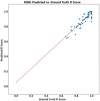Attention U-net for automated pulmonary fissure integrity analysis in lung computed tomography images
- PMID: 37644125
- PMCID: PMC10465516
- DOI: 10.1038/s41598-023-41322-y
Attention U-net for automated pulmonary fissure integrity analysis in lung computed tomography images
Abstract
Computed Tomography (CT) imaging is routinely used for imaging of the lungs. Deep learning can effectively automate complex and laborious tasks in medical imaging. In this work, a deep learning technique is utilized to assess lobar fissure completeness (also known as fissure integrity) from pulmonary CT images. The human lungs are divided into five separate lobes, divided by the lobar fissures. Fissure integrity assessment is important to endobronchial valve treatment screening. Fissure integrity is known to be a biomarker of collateral ventilation between lobes impacting the efficacy of valves designed to block airflow to diseased lung regions. Fissure integrity is also likely to impact lobar sliding which has recently been shown to affect lung biomechanics. Further widescale study of fissure integrity's impact on disease susceptibility and progression requires rapid, reproducible, and noninvasive fissure integrity assessment. In this paper we describe IntegrityNet, an attention U-Net based automatic fissure integrity analysis tool. IntegrityNet is able to predict fissure integrity with an accuracy of 95.8%, 96.1%, and 89.8% for left oblique, right oblique, and right horizontal fissures, compared to manual analysis on a dataset of 82 subjects. We also show that our method is robust to COPD severity and reproducible across subject scans acquired at different time points.
© 2023. Springer Nature Limited.
Conflict of interest statement
Drs. Hoffman and Reinhardt are shareholders in VIDA Diagnostics, Inc. Zachary Althof was formerly employed by VIDA Diagnostics, Inc. Drs. Gerard and Reinhardt have US patent 11,475,562 on the FissureNet fissure segmentation method. Drs. Galizia and Eskandari do not have any competing interests.
Figures







References
-
- Galloy AE, Amelon RE, Reinhardt JM, Raghavan ML. Contact mechanics model of lung lobar sliding. Appl. Eng. Sci. 2022;10:100098.
Publication types
MeSH terms
Grants and funding
- HHSN268200900019C/HL/NHLBI NIH HHS/United States
- U24 HL141762/HL/NHLBI NIH HHS/United States
- P30 ES005605/ES/NIEHS NIH HHS/United States
- T32 HL144461/HL/NHLBI NIH HHS/United States
- HHSN268200900015C/HL/NHLBI NIH HHS/United States
- HHSN268200900016C/HL/NHLBI NIH HHS/United States
- HHSN268200900013C/HL/NHLBI NIH HHS/United States
- HHSN268200900014C/HL/NHLBI NIH HHS/United States
- R01 HL142625/HL/NHLBI NIH HHS/United States
- U01 HL137880/HL/NHLBI NIH HHS/United States
- HHSN268200900018C/HL/NHLBI NIH HHS/United States
- P30 DK054759/DK/NIDDK NIH HHS/United States
- HHSN268200900017C/HL/NHLBI NIH HHS/United States
- HHSN268200900020C/HL/NHLBI NIH HHS/United States

